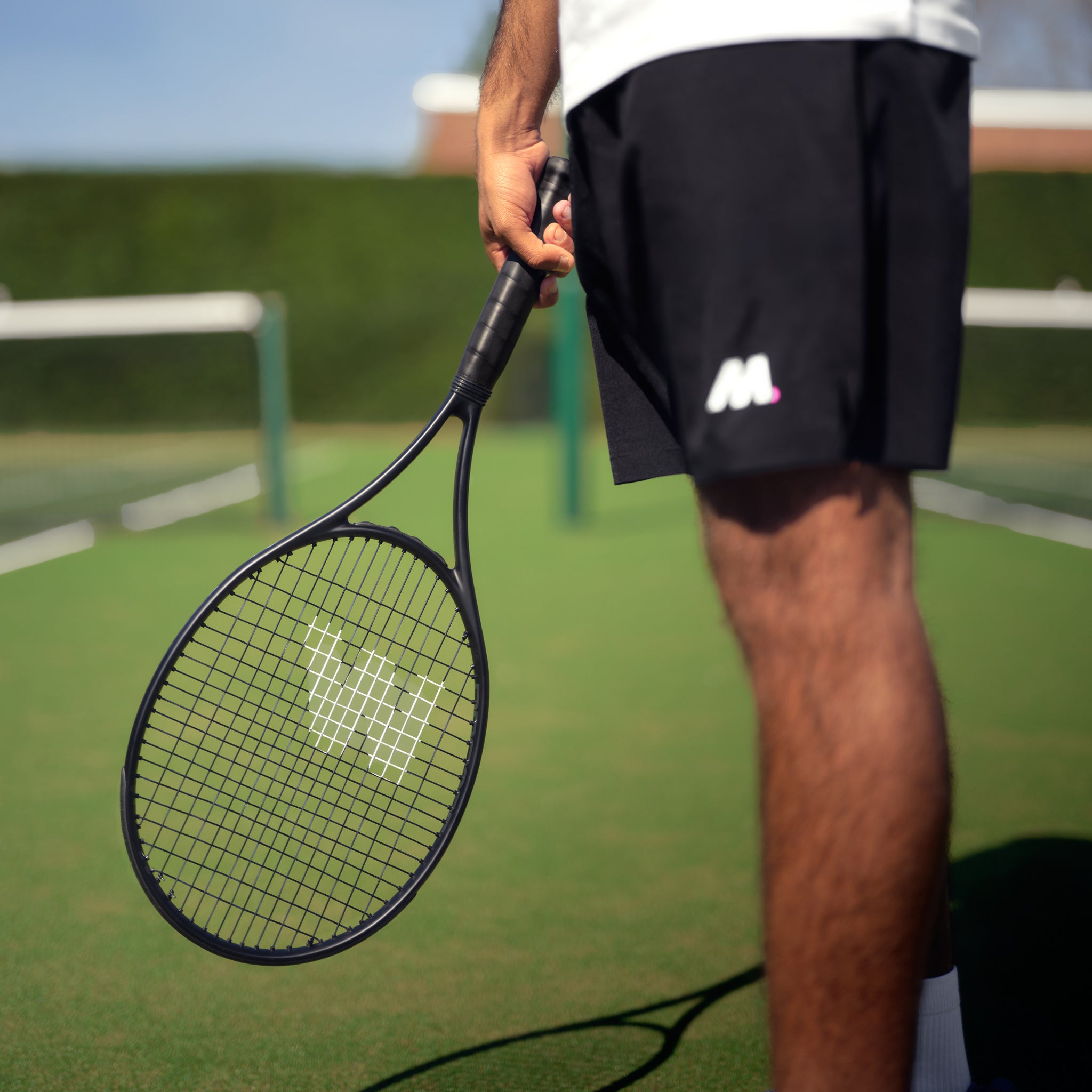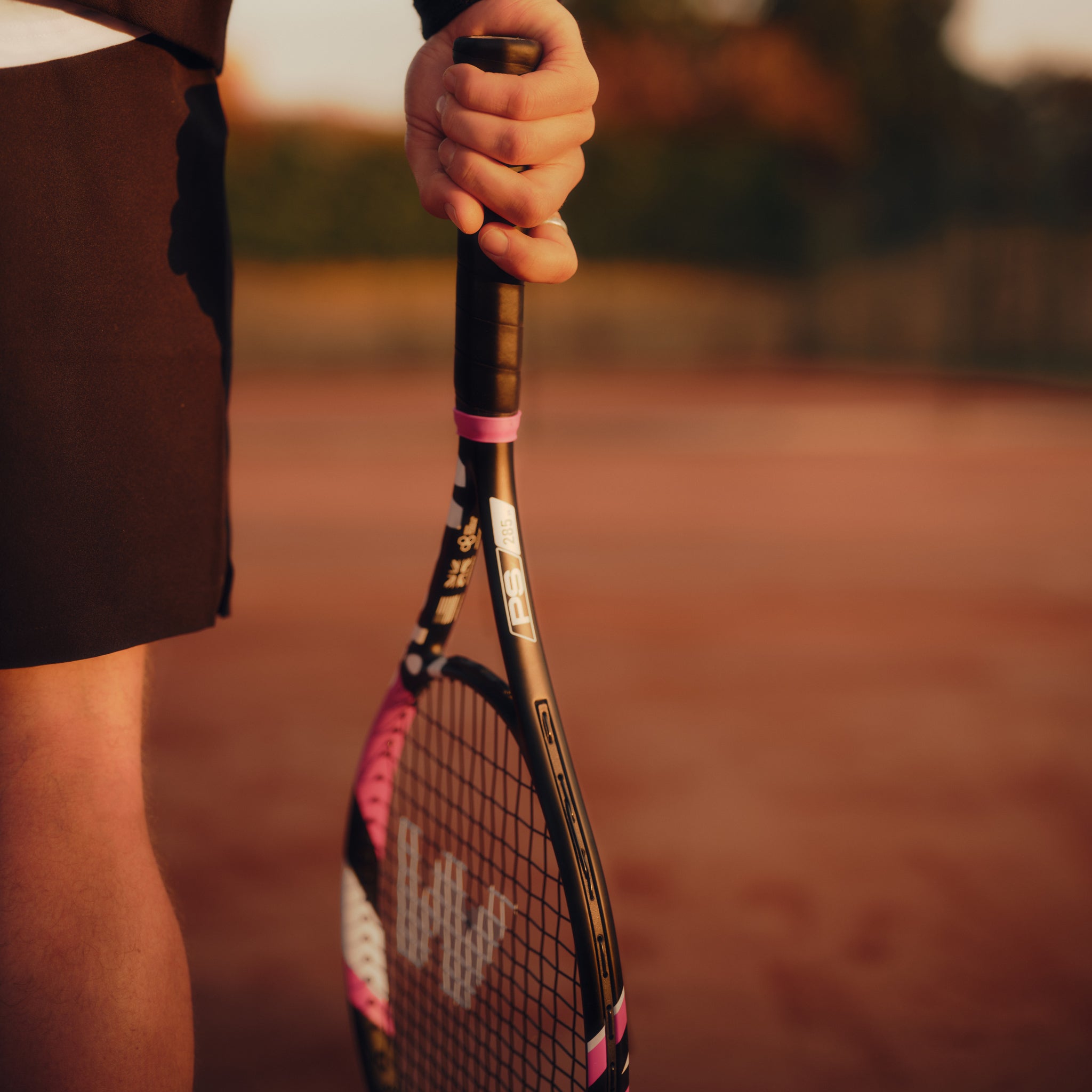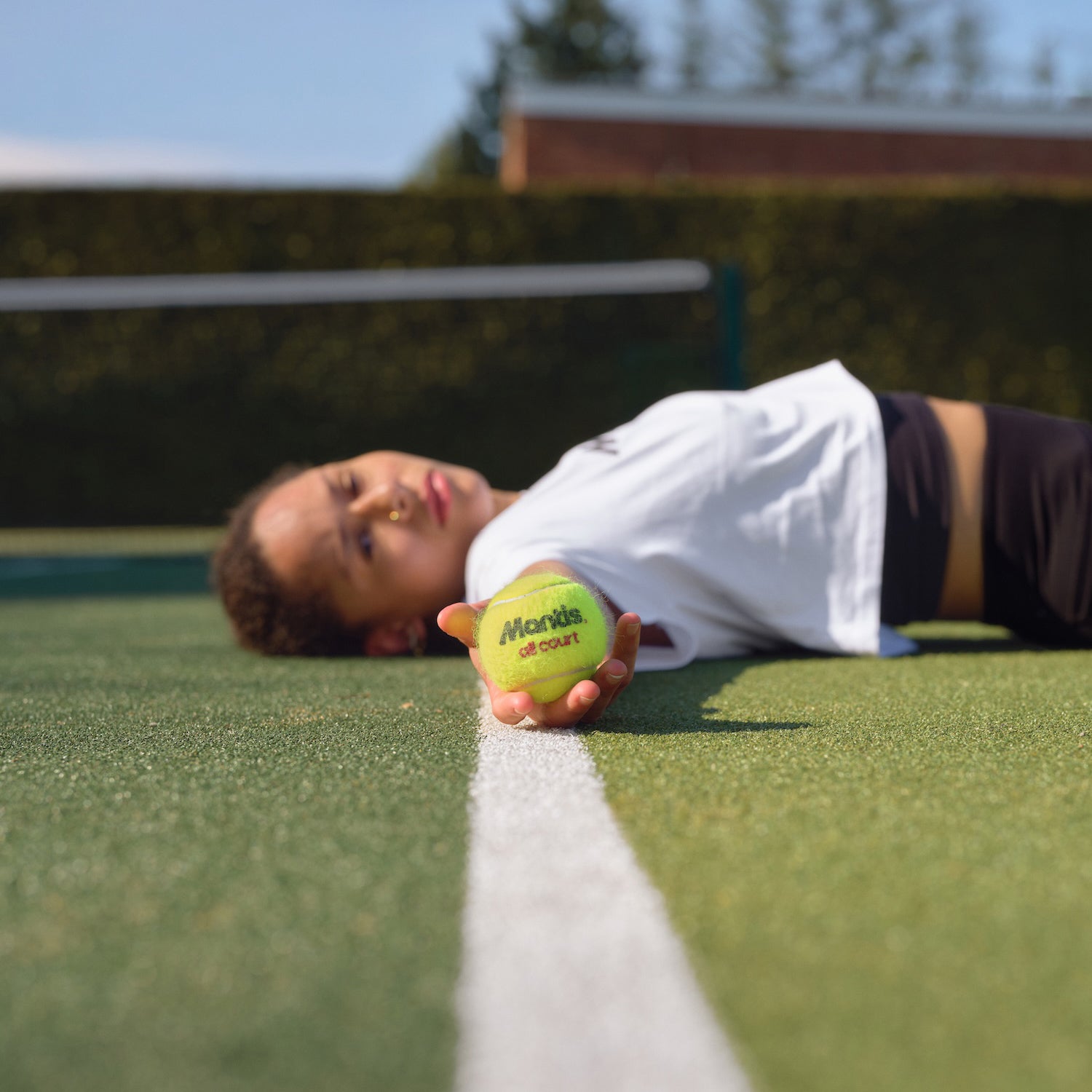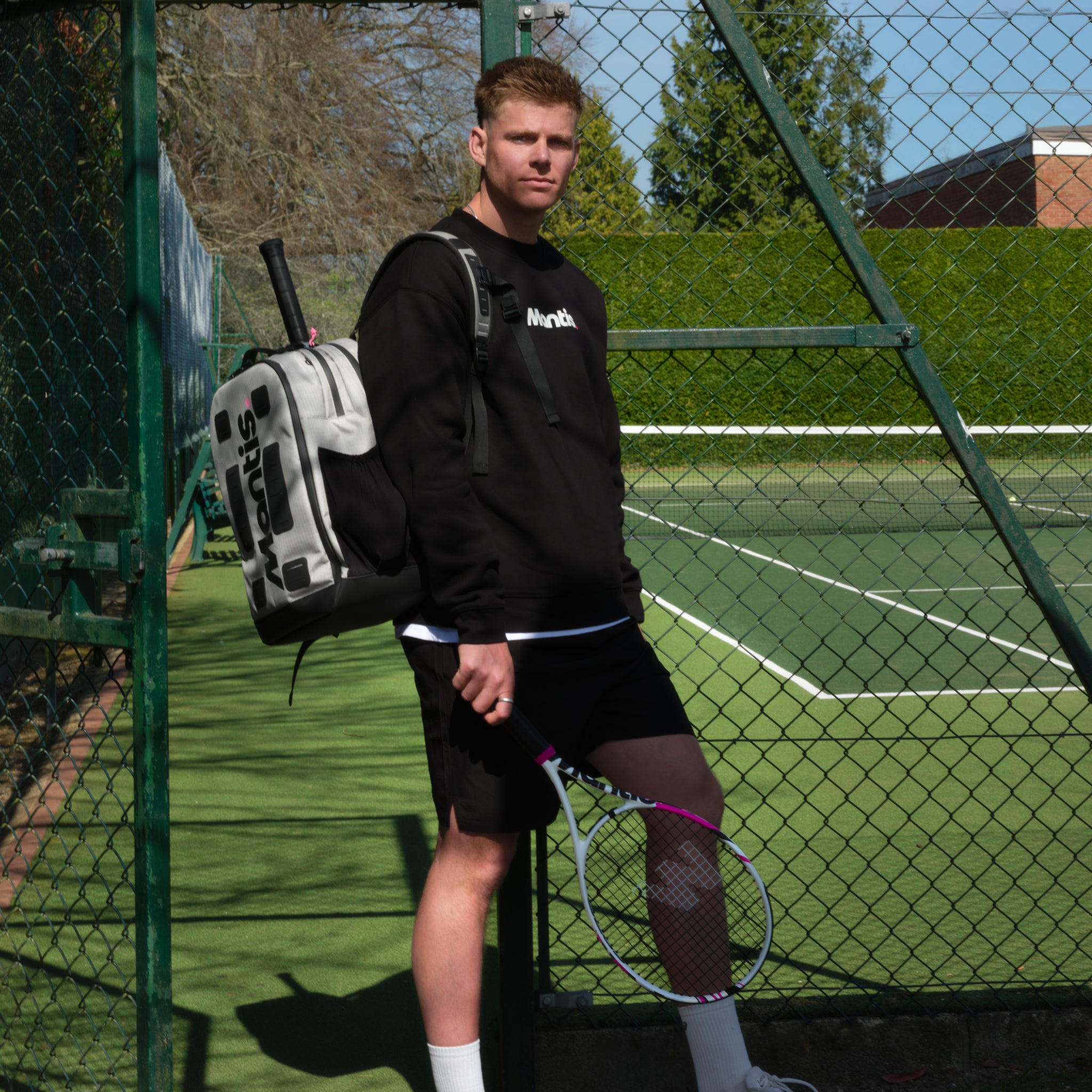
Ever thought about picking up a tennis racket but worried you’ve left it a bit late? We're here to put that concern to rest: it's never too late to start playing. Tennis lessons for adults are specifically designed for everyone, regardless of age or current fitness level, with a real focus on building your skills in a fun, supportive atmosphere.
Why It Is Never Too Late to Learn Tennis
The idea that you need to be young to learn a sport is a complete myth. At Mantis, we see every single day how tennis stands apart as a genuine lifelong activity. Unlike some high-impact sports that can take a toll on your body over the years, tennis can be dialled up or down to match your personal fitness, whether you’re chasing competitive glory or just want a friendly rally with friends.
We get it. Starting something new can feel a little intimidating. That's why our coaching philosophy at Mantis is built from the ground up to make the game accessible and, most importantly, enjoyable for everyone—especially adults stepping onto the court for the very first time.
The journey starts with that first lesson, and you'll find the path to playing is much easier than you think. Modern tennis lessons for adults are structured to build your confidence right from day one.
A Welcoming and Growing Community
If you’re thinking about starting, you’re in good company. Adult tennis has seen an incredible resurgence across the UK. In fact, the number of adults playing tennis shot up by a staggering 43% in just one year, jumping from 3.3 million to 4.7 million players in 2022. This boom means there's a vibrant and growing community ready to welcome new faces.
This isn't just a statistic; it means more opportunities to play, more potential hitting partners, and a richer social scene built around the sport. It's about so much more than learning a forehand—it's about joining a community.
Tennis is a fantastic way to combine physical activity, mental strategy, and social interaction. For adults, it offers a perfect escape from daily routines, providing a challenging yet rewarding hobby that benefits both body and mind.
Benefits Beyond the Baseline
The payoffs for starting tennis as an adult go far beyond just what happens between the white lines. Here are just a handful of the rewards you can look forward to:
- Improved Physical Health: Tennis is a fantastic full-body workout. It gets your heart rate up, improving cardiovascular fitness while also boosting your agility and coordination.
- Enhanced Mental Acuity: This isn't just a physical game. The strategy involved keeps your mind sharp, demanding focus, planning, and quick problem-solving.
- Stress Relief: There's nothing quite like hitting a tennis ball to leave the day's worries behind. Engaging in a physical activity you truly enjoy is a proven way to reduce stress and lift your mood.
- Social Connections: Whether it's in group lessons or at a local club, tennis is an excellent way to meet new, like-minded people.
Choosing the Right Tennis Lesson Format
So, you’re ready to take some tennis lessons for adults. Fantastic. The first step, and it's a big one, is picking the right lesson format. Think of it like choosing the right tool for a job – you wouldn't use a sledgehammer to hang a picture frame. The best format for you boils down to your personal goals, your budget, and how you learn best.
At Mantis, our goal is to cut through the confusion and help you find a clear path onto the court. If you're completely new to the game, our complete guide on tennis lessons for beginners is a great place to start building that foundation.
Let's use an analogy. If your tennis game is a car, a private lesson is like hiring a personal mechanic. It’s all about focused, one-on-one attention to diagnose and fix very specific issues, whether that’s tweaking your serve or rebuilding your backhand from the ground up. It’s the fast track for targeted improvement.
Group lessons, on the other hand, are more like a hands-on workshop. They're brilliant for learning the fundamentals in a social, high-energy setting. You don't just learn from the coach; you learn from hitting with others, making it a perfect fit if you enjoy a team atmosphere and want to meet fellow players.
To help you weigh the options, here's a quick breakdown of the most common formats.
Comparing Formats of Tennis lessons for adults
| Lesson Type | Best For | Average Cost (Estimate) | Key Benefit |
|---|---|---|---|
| Private Lessons | Rapid, targeted improvement and fixing specific technical flaws. | £40 - £80+ per hour | Undivided attention and personalised feedback from the coach. |
| Group Clinics | Beginners, social learners, and those on a tighter budget. | £15 - £30 per hour | A fun, social environment and the chance to practise with various players. |
| Cardio Tennis | Fitness enthusiasts looking for a high-energy workout. | £10 - £20 per session | A great calorie burn while still hitting lots of tennis balls. |
| Drill & Play | Players who want to apply lesson concepts in a match setting. | £20 - £35 per session | Bridges the gap between structured drills and competitive play. |
Ultimately, the right choice depends on what you want to achieve. A mix of formats can often be the most effective approach.
Private Lessons for Personalised Progress
Private coaching is, without a doubt, the quickest way to see detailed improvements in your technique. With your coach’s attention entirely on you, you get immediate feedback and on-the-spot adjustments. This is the ideal setup if you have a specific goal in mind, like getting ready for a club tournament or finally conquering a stubborn weakness in your game.
Yes, the initial cost is higher, but the focused instruction often means you get results much faster.
Group Clinics for Social Learning
For a more cost-effective and sociable entry into the game, group clinics are an excellent choice. They offer a structured curriculum in a lively setting, giving you the chance to run through drills and play points against a variety of partners.
The social side of group lessons is a huge motivator. Learning alongside others builds a natural support network that keeps you coming back to the court, turning what can be a solo pursuit into a genuinely shared experience.
This visual breaks down what adult players are really looking for in their coaching.
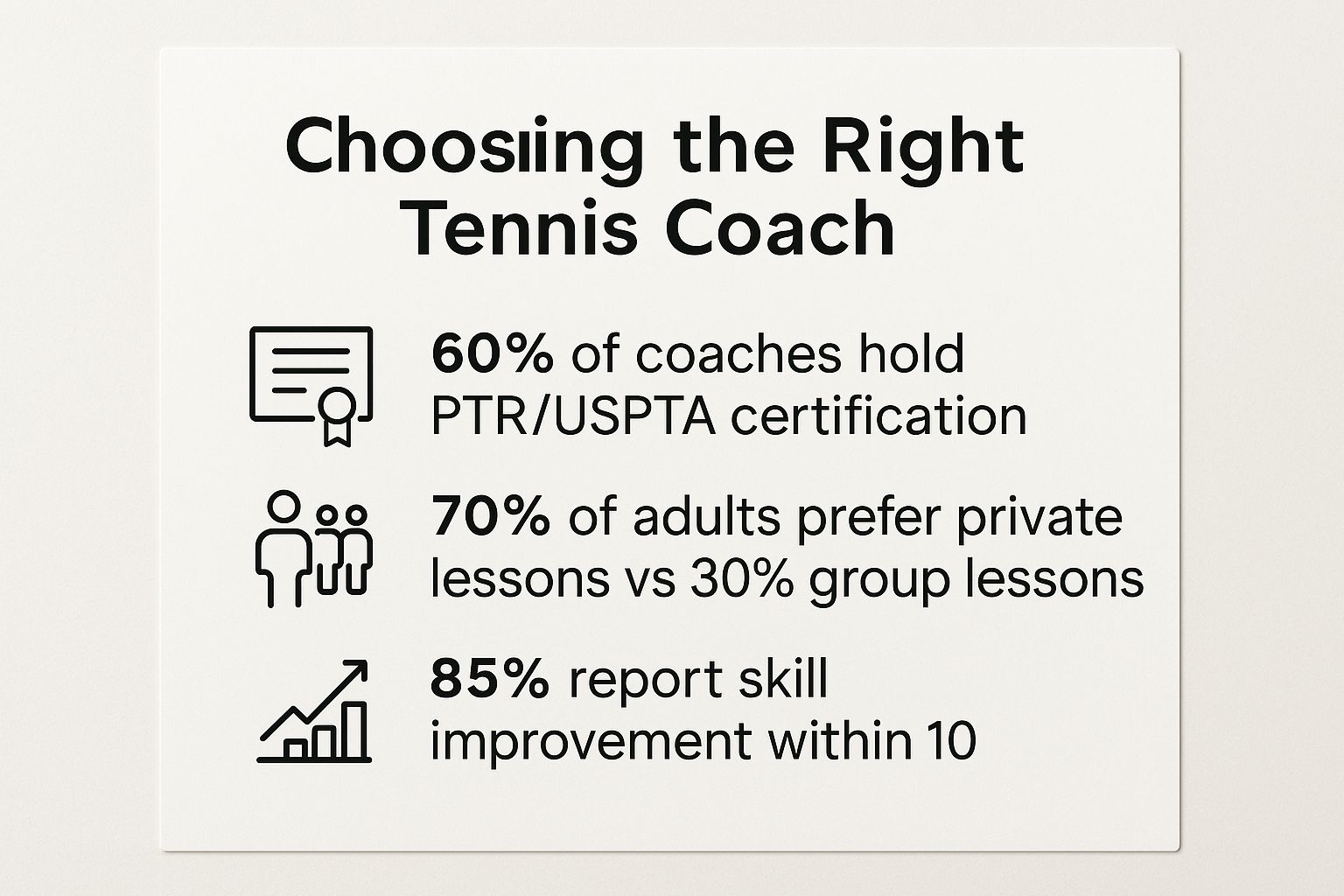
The data clearly shows a strong preference for private lessons among adults, which points to a real desire for personalised coaching. It also highlights just how quickly players can see skill improvements in a relatively short time.
Specialised Tennis Sessions
Beyond the standard private and group formats, you'll often find specialised classes designed for very specific outcomes. Here are a couple of popular ones you're likely to see:
- Cardio Tennis: This is less about perfecting your technique and all about getting a fantastic workout. It’s a high-energy group session, usually set to music, packed with fast-paced drills designed to get your heart rate up and keep it there.
- Drill and Play: These sessions are the perfect bridge between a lesson and a real match. They typically involve an hour of intensive, focused drills followed by supervised match play, helping you take what you’ve just learned and apply it under pressure.
The True Benefits of Professional Coaching
Taking up tennis lessons for adults is about so much more than learning to whack a ball over the net. It’s a real investment in yourself—both physically and mentally. While you can certainly teach yourself the basics, the focused guidance you get from a professional coach offers benefits you just can't replicate on your own.
For a deeper look at getting started, our complete Mantis guide on tennis lessons for beginners is a great place to set the stage for your journey.
Good coaching speeds up your learning curve in a huge way. A coach gives you instant, expert feedback, catching those small technical mistakes before they become deeply ingrained habits. It’s a bit like an architect making sure a house has solid foundations; it prevents major problems down the road.
This foundational work is what allows for long-term enjoyment and real improvement. Without it, players often hit frustrating plateaus, stuck wondering why their shots are so inconsistent or why they can’t seem to break through to the next level. Think of your coach as your personal mechanic, fine-tuning every part of your game for better efficiency and power.
Developing Your Technical Skills
The most obvious benefit of pro coaching is getting your technique right. A good coach will break down what feel like complicated movements into simple, manageable steps, helping you truly master the fundamentals of a solid swing.
You'll see immediate improvement in key areas like:
- Proper Grip and Stance: Learning how to hold the racquet and position your body is the first building block for consistent, reliable shots.
- Efficient Swing Mechanics: A coach will help you build a fluid, powerful swing for your forehand, backhand, and serve, which also helps reduce the risk of injury.
- Footwork and Movement: Tennis is all about movement. You'll learn how to move effectively on the court so you're always in the best possible position to hit the ball.
Gaining a Tactical Advantage
Once your technique is solid, a great coach will start shifting the focus to the strategic side of the game. Tennis is often called physical chess, and learning to think tactically is what really separates good players from great ones.
You’ll start learning about point construction—how to use a sequence of shots to create an opening—and how to spot and exploit an opponent’s weaknesses.
A coach teaches you to see the entire court, not just the ball. You stop reacting and start anticipating, turning defensive situations into offensive opportunities and controlling the flow of the match.
More Than Just a Game
Beyond the strokes and strategies, the holistic benefits of professional coaching are profound. Fully engaging in an activity that is both challenging and rewarding is a powerful way to relieve stress. The intense focus you need during a lesson pushes daily distractions aside, almost like a form of active meditation.
And physically, the structured drills and match play deliver significant health perks. Regular lessons improve your cardiovascular health, boost agility, and build functional strength. Here at Mantis, we see it all the time—coaching transforms players by building not just their skills, but also their confidence, focus, and overall fitness. It truly creates a lifelong passion for the sport.
How to Find Your Ideal Tennis Coach
Finding the right coach is one of the most important decisions you'll make on your tennis journey. The right person can make you fall in love with the game for life, while the wrong fit can just lead to frustration and feeling stuck.
At Mantis, we want you to find a coach and a programme that not only matches your goals but also keeps that fire lit. We know that the best learning happens when you feel supported and are getting top-quality guidance.
This screenshot from a university tennis centre is a great example of what to look for. It shows a mix of adult programmes, from beginner courses to social play, which tells you they have a clear pathway for players. The best coaching is often found within these well-organised programmes that welcome all ability levels.
Start with Qualifications and Experience
First things first, look for a coach with recognised qualifications. In the UK, that means accreditation from the Lawn Tennis Association (LTA). An LTA badge isn't just a bit of paper; it's your assurance that the coach has met high standards for safety, training, and professionalism.
When you're checking out a coach’s credentials, here's a quick rundown of what the levels mean:
- Level 1-2 (Coaching Assistant): Qualified to help a head coach, usually in group lessons.
- Level 3 (Coach): A fully qualified coach who can independently lead both group and one-on-one lessons. For most adult players, this is the gold standard.
- Level 4-5 (Senior/Master Coach): These are the experts with vast experience. They're often training other coaches or working with elite, high-performance players.
But remember, a coach’s personality and how they teach are just as vital as their qualifications. A great coach knows how to explain tricky concepts in a simple way and can tailor their style to how you learn best.
Where to Find Your Coach
You don't have to join a pricey private club to find fantastic coaching. Great instruction is available in all sorts of places. Local community sessions, for instance, are brilliant for meeting people and developing your skills in a relaxed setting. These kinds of programmes are key to getting more adults into tennis by making lessons easy to access.
It can also be helpful to think about what makes a coach successful. Understanding their approach to their work, including things like effective coaching business marketing strategies, can give you a peek into their level of professionalism and dedication.
A Checklist for Choosing the Right Coach
Before you commit, it's always a good idea to book a trial lesson or at least have a quick chat. Use this checklist to help guide your decision:
- Do they ask about your goals? A good coach wants to know what you’re aiming for, whether it's winning a match or just hitting a clean backhand.
- Is their communication clear and encouraging? You should feel totally comfortable asking questions, no matter how basic.
- Did you actually enjoy the lesson? Having fun is one of the most powerful motivators for improvement.
- Are they organised and professional? This means turning up on time and being prepared for your session.
At the end of the day, finding the perfect match is all about connection. At Mantis, we believe you should trust your gut. Find someone who creates a supportive atmosphere that makes you excited to get on the court.
Right then, you’ve booked your first lesson. The last thing you want is to walk onto the court feeling flustered or unprepared. That first session should be exciting, not stressful.
A little bit of prep goes a surprisingly long way in settling those first-day jitters. At Mantis, our goal is to help you cut through the noise and focus on what actually matters, so you can step onto that court with confidence. Our guide on getting better at tennis is also a great read for getting into the right mindset.
Let's be clear: you don't need to show up with a bag bursting with expensive, high-tech gear. Honestly, the only two things you absolutely need to get right are a beginner-friendly racquet and a proper pair of tennis shoes. Everything else can wait.
Gearing Up The Right Way
Choosing your first racquet can feel like a minefield of jargon and options. The key is to keep it simple. Look for a racquet with a larger head size and a lighter weight. This combination gives you a bigger "sweet spot," which makes it far more forgiving as you're figuring out how to make clean contact with the ball.
Don’t feel you have to rush out and buy one immediately, either. Many coaches keep a stash of spare racquets for newcomers. Just ask ahead of time.
The one non-negotiable item, however, is your footwear. You need proper tennis shoes. Your running trainers won't cut it. They’re designed for straight-line movement, whereas tennis demands sharp, lateral cuts and pivots. Tennis shoes provide the crucial side-to-side support that helps prevent ankle rolls and other common court injuries.
Think of your equipment as a support system. A beginner racquet helps you find success early, and proper shoes protect your body. Getting these two things right sets a solid foundation for your entire tennis journey.
Mental and Physical Readiness
Beyond the gear, a little bit of physical and mental prep can make a world of difference. You don't need to hit the gym for an intense workout, but a simple warm-up is essential. Try to arrive 5-10 minutes early to do some light jogging on the spot, a few dynamic stretches like leg swings, and some gentle arm circles. It just gets the blood flowing and tells your muscles it's time to work.
Mentally, the most important thing is to manage your expectations. Your first lesson is all about the absolute fundamentals. You’ll be learning how to hold the racquet, understanding basic footwork, and simply trying to connect with the ball. You won't be cracking flawless aces on day one, and that’s perfectly fine. Nobody does.
Finally, be ready to talk to your coach. It’s a two-way street. Think about sharing a few things:
- Your Goals: What are you hoping to get out of this? A new social hobby? A great workout?
- Any Physical Concerns: Let them know about that dodgy knee or stiff shoulder from years ago.
- Your Learning Style: Do you learn best by watching, listening, or doing?
This quick chat helps your coach tailor the lesson specifically for you. From there, your only job is to listen, give it your best shot, and most importantly, have a bit of fun.
Navigating Your Tennis Learning Journey
Here’s something every tennis player learns, sooner or later: progress isn’t a straight line. It’s more like a rewarding, winding path with its own unique rhythm. At Mantis, we think setting realistic expectations and staying positive for the long haul are two of the most important skills you can develop. If you’re just starting out, have a look at our advice on getting better at tennis to get your head in the right space from day one.
The journey from learning the basic strokes to feeling confident in a friendly match is different for everyone. It’s so important to celebrate the small wins along the way—whether that’s hitting your first clean backhand down the line or holding serve for the first time in a practice game.
Those little victories are the fuel that will carry you through the inevitable plateaus. Every single player, from the rawest beginner to the seasoned pro, hits points where it feels like they aren't improving. It’s a completely normal part of learning any new skill.
Embracing Continuous Improvement
The real goal isn't to "master" tennis and then stop. It's to cultivate a genuine love for the process—the continuous improvement, the fitness, and the simple fun of it all. This mindset turns frustrating moments into learning opportunities and keeps you coming back to the court.
A structured environment can be a massive help in keeping that motivation alive.
Your Path Forward
Think of your learning journey in phases, each with its own focus and rewards.
- Phase 1: The Foundation. This is all about getting comfortable. You’ll be working on your grip, your stance, and just making clean, consistent contact with the ball.
- Phase 2: The Rally. Now you start moving your feet. The focus shifts to keeping a short rally going. Consistency is king here, not power.
- Phase 3: The Game. This is where you begin to understand scoring, basic tactics, and how to actually build points in a friendly match.
The ultimate message is that tennis is a journey, not a destination. With the right attitude and support, taking that first step onto the court will unlock a passion that benefits you for years to come.
At Mantis, we believe that every lesson, every rally, and every match is a step forward. Embrace the journey, be patient with yourself, and enjoy the incredible benefits that tennis lessons for adults bring to your life.
Right then, let's clear up some of those questions that might be bouncing around in your head. Starting anything new can feel a bit daunting, but we're here to make sure your first steps into adult tennis lessons are confident ones.
At Mantis, we've heard just about every query from new players. The good news? Getting on the court is far easier and more rewarding than you probably think. Let's tackle those last few uncertainties so you can get out there and start hitting.
Do I Need to Be Really Fit to Start Tennis Lessons?
Not at all. In fact, one of the best things about tennis is that it's a fantastic way to build your fitness at your own pace. There’s a common myth that you need to be a seasoned athlete before you even pick up a racket, and that’s simply not true.
Beginner lessons are all about learning the right technique and the basic movements of the game. A good coach knows how to work with every fitness level. Many programmes, like Cardio Tennis, are even designed specifically to boost your fitness while you learn. The most important thing is just to start—your stamina and agility will naturally improve as you play.
How Many Lessons Until I Can Play a Real Game?
This is the big question, and while it's a bit different for everyone, we find most adults can hold a rally and play a basic game after a course of 6-10 lessons.
The first few lessons are all about getting a consistent feel for your shots and a solid grasp of the rules. Your coach will guide you, and many group programmes cleverly weave game-like drills in early on. This helps build your confidence for that first friendly match.
Is Private or Group Coaching Better for a Beginner?
Both have brilliant advantages, so there’s no single "better" choice—it really comes down to what works for you.
- Group Lessons: These are easier on the wallet, very social, and a great way to learn the basics in a fun, low-pressure setting. You'll be on court with other players who are at the same stage as you.
- Private Lessons: This is your fast track. You get 100% personalised attention to fix specific issues and improve your technique quickly. Think of it as an investment in focused, accelerated learning.
A lot of beginners find a great rhythm by starting with group lessons to build a solid foundation. Once they're comfortable, they might book a few private sessions to really dial in a specific skill, like their serve or backhand. At Mantis, we believe the right choice is the one that fits your learning style, budget, and what you want to get out of tennis.
